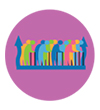
Any organisation can be seen as a distinct existing entity, exposed to the influence of its external and internal environment. Since the business macro-environment is not stable and is changing continuously over time, its factors should be regularly considered by firms, organisations, etc., when setting up their strategy for meeting changing demands and facing new challenges.
Global market and societal trends play an important role in the way different consumer/passenger groups define or adjust their travel behaviour. These trends refer to Legal, Technological, Political, Economic, Demographic, Geographical, Societal, Cultural and Ecological changes.
If you wish to make the Public Transport in your city more innovative, you should recognise these trends and try to introduce innovations with a view to address them.
CIPTEC has identified a number of major market and societal trends that are highly likely to affect the demand for Public Transport services in European cities over the next years. These trends were evaluated in terms of their expected increase and impact on the Public Transport demand.
Based on the results of this CIPTEC survey, Public Transport Operators and Public Transport Authorities have been recommended to adopt specific policy instruments over the next 10 years to effectively meet these trends (at EU level).
 Innovative Technologies: technological advancements render the travelling experience more efficient and enjoyable. Transport users plan their trips more effectively. Vehicles are cleaner and safer.
Innovative Technologies: technological advancements render the travelling experience more efficient and enjoyable. Transport users plan their trips more effectively. Vehicles are cleaner and safer.
Main Policy instruments: Vehicle Technologies and Design, Digital Services and Marketing and Mobility Management
 Population ageing: life expectancy increases, while birth rates decrease. Cities and Transport are called to accommodate a higher proportion of elderly people with distinct requirements.
Population ageing: life expectancy increases, while birth rates decrease. Cities and Transport are called to accommodate a higher proportion of elderly people with distinct requirements.
Main Policy instruments: Vehicle Technologies and Design, Marketing and Mobility Management, Network Infrastructure
 Globalisation: social, economic and physical boundaries fade. The mobility of goods and people increases. Travelling becomes easier and more affordable for Europeans.
Globalisation: social, economic and physical boundaries fade. The mobility of goods and people increases. Travelling becomes easier and more affordable for Europeans.
Main Policy instruments: Business models, Network Infrastructure, Organizational changes
 Sustainable Lifestyles: people are becoming increasingly aware of their energy consumption and their carbon footprint. More and more individuals consciously opt for healthy, sustainable and ‘alternative’ lifestyles and travel options.
Sustainable Lifestyles: people are becoming increasingly aware of their energy consumption and their carbon footprint. More and more individuals consciously opt for healthy, sustainable and ‘alternative’ lifestyles and travel options.
Main Policy instruments: Vehicle Technologies and Design, Marketing and Mobility Management, Digital Services supporting Public Transport
 Social innovation: an increasingly high number of individuals and organisations from the public and private sector, as well as from civil society, are developing new products and services to meet social needs. New ways of thinking urban mobility emerge.
Social innovation: an increasingly high number of individuals and organisations from the public and private sector, as well as from civil society, are developing new products and services to meet social needs. New ways of thinking urban mobility emerge.
Main Policy instruments: Marketing and Mobility Management, Business models, Digital Services
 Flexible Economy: a growing number of companies offer flexible work schedules and remote working options to their employees. Travel patterns are changing.
Flexible Economy: a growing number of companies offer flexible work schedules and remote working options to their employees. Travel patterns are changing.
Main Policy instruments: Business models, Marketing and Mobility Management, Digital Services
 Urbanization: towns and cities become larger as more and more people move to city centres. The inhabitants of those areas demand shorter and more frequent journeys.
Urbanization: towns and cities become larger as more and more people move to city centres. The inhabitants of those areas demand shorter and more frequent journeys.
Main Policy instruments: Network Infrastructure, Vehicle Technologies and Design, Digital Services
 Urban governance: more decisions are made at the city level. Regional and local authorities strive to come forth as innovators and develop a distinguished brand, promoting ‘sustainable’ and ‘smart’ transportation.
Urban governance: more decisions are made at the city level. Regional and local authorities strive to come forth as innovators and develop a distinguished brand, promoting ‘sustainable’ and ‘smart’ transportation.
Main Policy instruments: Organizational changes, Business models, Network Infrastructure
 Shared Economy: people increasingly share human, physical and intellectual resources. Travellers can now share vehicles using social networking platforms for car-pooling and car-sharing.
Shared Economy: people increasingly share human, physical and intellectual resources. Travellers can now share vehicles using social networking platforms for car-pooling and car-sharing.
Main Policy instruments: Business models, Marketing and Mobility Management, Digital Services
 Individual Empowerment: people are better educated, more entrepreneurial and tech-savvy. They claim their rights and pressure transport authorities to accommodate their needs and demands.
Individual Empowerment: people are better educated, more entrepreneurial and tech-savvy. They claim their rights and pressure transport authorities to accommodate their needs and demands.
Main Policy instruments: Marketing and Mobility Management, Digital Services, Business models
 Corporate social responsibility: a large number of businesses, including Public Transport Operators, voluntarily commit themselves to behaving ethically and promoting end users’ health and quality of life.
Corporate social responsibility: a large number of businesses, including Public Transport Operators, voluntarily commit themselves to behaving ethically and promoting end users’ health and quality of life.
Main Policy instruments: Business models, Marketing and Mobility Management, Organizational changes
 Transforming households: a growing share of the population remains childless or has children at a later age, while divorce rates increase. As the average size of households diminishes, families display different transportation needs.
Transforming households: a growing share of the population remains childless or has children at a later age, while divorce rates increase. As the average size of households diminishes, families display different transportation needs.
Main Policy instruments: Marketing and Mobility Management, Network Infrastructure, Vehicle Technologies and Design
 Urban Sprawl: parts of the population move away from central urban areas into low-density, monofunctional and car-dependent communities. The ‘last mile’ issue becomes more critical than ever.
Urban Sprawl: parts of the population move away from central urban areas into low-density, monofunctional and car-dependent communities. The ‘last mile’ issue becomes more critical than ever.
Main Policy instruments: Network Infrastructure, Vehicle Technologies and Design, Marketing and Mobility Management
 Environmental degradation: natural resources become depleted, ecosystems are destructed and climate changes. Oil prices increase. Environmental policies of all scales include measures affecting transport.
Environmental degradation: natural resources become depleted, ecosystems are destructed and climate changes. Oil prices increase. Environmental policies of all scales include measures affecting transport.
Main Policy instruments: Vehicle Technologies and Design, Business models, Network Infrastructure
 EU Legislation: the European Commission puts forward regulations for building a competitive transport system that will increase mobility, remove major barriers in key areas and fuel growth and employment. National governments are called to comply.
EU Legislation: the European Commission puts forward regulations for building a competitive transport system that will increase mobility, remove major barriers in key areas and fuel growth and employment. National governments are called to comply.
Main Policy instruments: Business models, Organizational changes, Network Infrastructure
Consider the peculiarities of your city and its special characteristics in order to understand which global trends may be more critical and influential at your local level.
- How do you think that a particular trend will influence the behaviour of the travellers?
- How should your respond to this evolution?
Try to answer these questions, as these considerations will affect how you will prioritise the objectives of your organization and thus, the innovation strategy that you will plan.